Selecting the best set of strings for your violin is not an easy task because nowadays there are so many brands, core materials, tensions and characteristics that make it difficult to know which one will sound the best.
The truth is that there is no way to know how a set of violin strings are going to sound unless you install and use them. It is also important to point out that each violin is different even if it’s made by the same luthier or factory because there are many factors that can affect the sound of the instrument.
What this means is that there is no one set of string that is going to sound great on all violins, as one brand of strings can sound great on one violin while not as good if used in another.
The purpose of this article is to present the top 10 best violin strings selected using a set of guidelines to make it easier for you when choosing.
The top 10 best violin strings for 2019 are:
- D’Addario – Prelude
- Super Sensitive – Red Label
- Fiddlerman
- D’Addario – Helicore
- Thomastik – Infield Dominant
- Pirastro – Evah Pirazzi
- Pirastro – Obligato
- Thomastik – Peter Infeld
- Pirastro – Oliv Series
- Pirastro – Evah Pirazzi Gold
Also, we have included the guidelines used to select each set of strings as a buyer’s guide to provide you with the basic knowledge about the different features and characteristics needed to be taken in consideration so that you can make an educated decision when choosing a set of strings for your violin.
Moreover, featured are some of the frequently asked questions about violin strings, to help the user have a more complete understanding of the subject.
D’Addario – Prelude
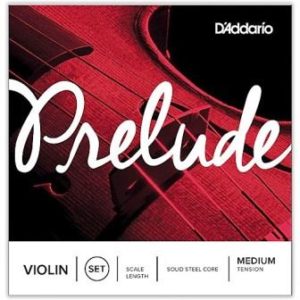
Prelude violin strings are made using a solid steel core. For this reason, these strings are virtually unaffected by changes in temperature and humidity. Thanks to D’Addario’s damping technology these affordable strings produce the warmest sound available in steel core strings at this price range.
When it comes to value, durability, and tone, Prelude is by far the best violin string for beginners. Violin teachers prefer this string for their students when they are in the beginning stages of violin playing.
Key Features:
- Designed with quick bow response and ease of use in mind.
- Optimized solid steel core that delivers the warmest-sounding student strings available.
- Educator’s preferred choice for student strings because they are economical, durable and provide the right tone.
- More pitch-stability means less time tuning.
- Durable and humidity and temperature resistant.
- This strings as all D’Addario strings are designed, engineered and manufactured in the USA to the most stringent quality controls in the industry.
Super Sensitive – Red Label
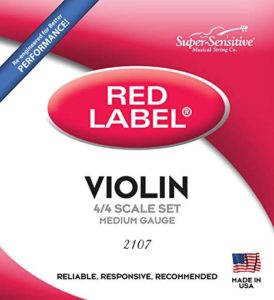
One of the most popular brands for beginner violinist is Super Sensitive’s Red Label violin strings. These strings provide good sound quality for anyone just getting started on the violin, as they are designed specifically for students.
These strings have a solid steel core to them and are good replacement strings. Due to their multiple sizes, Super Sensitive’s brand is good for all violin sizes, including children’s violins. In terms of strings for practicing, these are the best option around, but they are not great for long-term use or for solo performances.
Key Features:
- Designed specifically for students, making them easy to install and easy to use.
- High-quality materials, making the strings more durable than other beginner violin string brands.
- Meant for musicians of all ages.
- Economically priced, making them affordable.
- Multiple sizes.
Pros:
- Easy to install.
- Good tone quality.
- Durable.
- Produce a warm tone.
- Fits on any violin size.
- Great for practicing.
- Economically priced.
Cons:
- Tend to stretch over time.
- Have been known to break when used daily for a time span of three months.
- Some users have complained that in some violins the sound is squeaky.
Fiddlerman
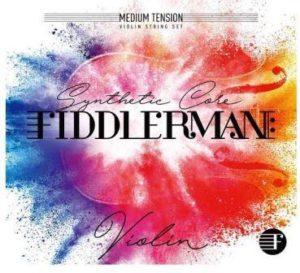
Fiddlerman is a German-made violin string with a synthetic core that sounds richer than most other beginner’s violin strings. The synthetic core is a more expensive alternative to a steel core and uses Perlon, a type of nylon that is extremely durable.
By switching to a synthetic core, the strings have a smoother finish to them which can be heard in the sound quality they put out. Fiddlerman is a great beginning string, especially for those who want to test out different cores to decide their string preferences.
Key Features:
- Uses a synthetic (Perlon) core, stepping away from the steel-string.
- Sound quality is so rich it is difficult to distinguish these strings from a more professional-grade string.
- All strings in this brand have ball ends.
- Strings are the best in well-matched tone quality.
Pros:
- Synthetic core provides a richer tone than steel core
- Consistent sound.
- Takes very little time to settle
- All strings are packed carefully to avoid corrosion or any other possible damage during shipping and arrival.
Cons:
- Due to the nature of Perlon, the string can begin to unravel over time.
- Known to break often.
- Some users have complained that is some Chinese violins the “A” string sounds off-tune.
D’Addario – Helicore
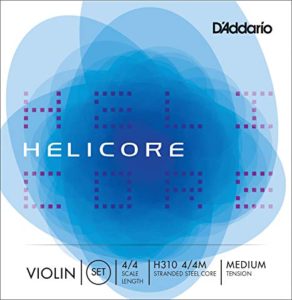
Helicore by D’Addario is the last set of violin strings we want to recommend in the beginner’s category. Among the previously mentioned set of strings, this one stands out as the best violin strings for beginners, especially those who are practicing to become intermediate violin players.
These strings have a steel core, which is fairly standard among violin strings. There are three choices for tensions, ranging from light to hard, and the most recommended for beginners is the medium tension.
The amount of versatility in these strings is perfect to help beginners find their favorite style of playing and is used by professionals and students alike, making it the perfect string to assist beginners to go into the next level of professional violin playing.
Key Features:
- All D’Addario strings are manufactured in the USA, with extreme quality control for the best sounding strings possible.
- It has a steel core that uses the stranding method, producing the highest quality for beginner violinists, and helping with durability.
- Due to its way of manufacture these strings provide versatile playability, these strings accommodate all playing styles associated with the violin.
- Their smaller size gives a great, quick response to bows.
Pros:
- Range of tensions.
- High-quality sound that is unique.
- Good bow response.
- Versatile playability.
Cons:
- D string is known to break.
- More expensive than most brands.
- Takes more time to stabilize.
Thomastik – Infield Dominant

One of, if not the most widely used string among intermediates violin players is Thomastik’s Infield Dominant strings. These strings are excellent for experienced beginners and intermediate students.
As beginner students switch to intermediate playing, these flexible, multi-strand nylon core delivers a tone comparable in sound and feel to natural gut strings which will help the student appreciate a better tone without using cheap, scratchy strings.
A full set includes All Ball-End Aluminum/Perlon “A”, Aluminum/Perlon “D”, Silver/Perlon “G”, and Ball-End Steel “E”.
Key Features:
- These strings use coatings of aluminum and silver over a synthetic (Perlon) core, making the tone rich and warm.
- Recommended by music teachers due to the richer, warmer sound that beats out brighter violin strings.
- The material used makes them resistant to changes in temperature, humidity, and climate.
- Tonal quality is a perfect, medium balance of sound, not too harsh, and not too soft, making the playability extremely versatile.
Pros:
- Good for teaching proper violin methods.
- Richer sound than other strings.
- Music teachers recommended.
- It can be used on many types of violin, including electric.
- Incredibly easy to tune, even for beginners.
Cons:
- It can be very sensitive to set up.
- When installed the can sound metallic at first, but after the strings break in they sound warmer and fuller.
Pirastro – Evah Pirazzi

Pirastro’s Evah Pirazzi strings claim to be the “soloist’s choice” when it comes to intermediate violin strings. These strings have a couple of variations to them, making them great for intermediates who want a specific sound to their violins.
Their core is synthetic, not steel, which warms the tone of the violin’s sound. Perfect for performances, these strings project loudly, and Pirastro has made specific strings that will produce an even louder sound than imagined.
These strings help budding violinists become expressive in their music, making it the perfect option for those seeking a unique quality to their sound.
Key Features:
- Two variations of string: E-platinum, a platinum-coated string over the synthetic core that produces an easy transition between notes and a warm sound, and the E-gold steel, coated in gold, which has a powerful, bright tone.
- The strings are not affected at all by climate, humidity, or temperature changes.
- Both loop end and ball end available on all strings in the set.
Pros:
- Great for projection purposes.
- Unique tonal quality.
- Options for the choice of string.
- Very responsive to different bow techniques.
Cons:
- More expensive than other strings.
- Quick turnaround, if used daily, they tend to become dull in 3 to 4 months.
Pirastro – Obligato
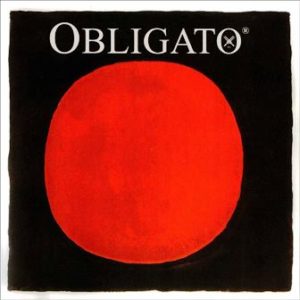
The Obligato version of Pirastro’s synthetic violin strings is top-notch and definitely performance-ready. Intermediates who want a more classical, rich sound will love this brand, as it’s synthetic core is similar to that of a steel core but with a richer quality to the sound.
This specific string doesn’t offer the platinum or gold options, but they offer aluminum coating, “A”- chrome steel, and “D”- aluminum for the best variety of string sounds a violinist could get. These strings are recommended for any intermediate seeking to perform at a higher level.
Key Features:
- The variations in string coatings for a multitude of sounds and a unique tone.
- Synthetic core, different from the classical steel, but with classical undertones.
- Strings come in multiple sizes to fit different violins.
- These strings will give musicians a dynamic range they have never experience before with other intermediate strings.
Pros:
- Variety of sounds.
- Great for classical performing with a modern string.
- Very durable, not as breakable as some brands.
- Complex tone.
- Easy to tune.
Cons:
- On the more expensive side.
- Has a “darker” sound.
- Takes a week to take on their true sound.
- Need to be tuned quite often for the best quality.
Thomastik – Peter Infeld
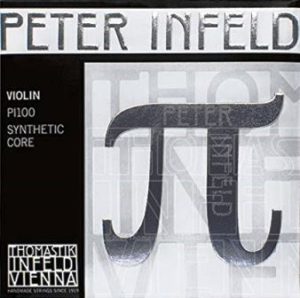
Thomastik’s Peter Infeld strings are the perfect choice for a violinist looking to have a dark, rich tone in their music. These strings are filled with emotion and character, making them great for both solo performances and orchestral work alike.
The craftsmanship is high in quality, and these strings will not disappoint. The synthetic core makes the volume and projection of these strings second to none, and they produce an extremely emotional tone. Definitely not for beginners, these are recommended for experts who want to convey a certain feeling in their music.
Key Features:
- With a synthetic core and high-quality material, these strings produce a sound that will have listeners captured in awe.
- The tone of these strings is a perfect blend of elegance and power.
- Bow response is phenomenal, with very low string resistance.
- Wide variety of metal coatings for different sounds, including platinum, silver, and aluminum.
- Offers both ball end and loop end to the strings.
Pros:
- Great for a darker tone in music.
- Easy to work with.
- Bows glide like butter across the strings.
- Long-lasting and durable.
Cons:
- Not suitable for every violin type.
- Research with your violin type required before purchase.
Pirastro – Oliv Series
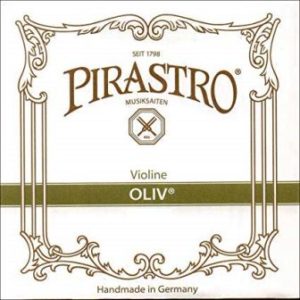
The Oliv series of Pirastro’s violin strings have an incredibly unique feature, which is the core of the string itself. These strings are handmade, and have a sheep gut core that is wound, making them perfect for violinists who prefer a Baroque set-up on their instruments.
Of all the expert strings, this series from Pirastro is by far the best and is highly recommended by many professional musicians and violin experts around the world. The strings fit well with almost any instrument and playing style, and they have a sound quality that is beyond any other brand or type of string.
Key Features:
- The Oliv series has a sheep gut core, which provides a more complex, warm tone to the sound quality of the instrument.
- These strings fit with most violin types.
- There are a variety of metal coatings for different sound options.
- Equated to an artist’s palette, these strings are said to expand the “musician’s palette.”
- Available with both the ball end and the loop end on the strings.
Pros:
- Good for Baroque style violin set-ups.
- Complex and colorful tones.
- Good for nearly all styles of violin style playing.
- Unique, set apart from all other violin strings.
Cons:
- Expensive.
- Can be affected by changes in temperature and humidity.
Pirastro – Evah Pirazzi Gold

It’s no secret by now that Pirastro has offered some of the best violin strings to musicians, but their Evah Pirazzi Gold strings are a step above in sound quality and brightness. These strings produce a “golden” tone, much like their name would suggest.
They are great for bright, complex performances, and will not leave any violinist wanting for more. Experts who want to experience the widest range imaginable will love these strings, as they allow for a beautiful, mixed range of tones and notes that other strings cannot accomplish.
Key Features:
- The string core is a synthetic one, with multi-fiber filaments.
- These strings produce a bright, golden tone and will allow for warm tones from the very bottom of heir register, to the very top.
- Astoundingly instantaneous bow response for all notes.
- Wide range of dynamics and registers helps to allow expert violinists to explore the realms of music in a clean and easy way.
Pros:
- Wide range of dynamics and register.
- Great for projecting sound.
- Variety of metal coatings for strings.
- Great for solo performances.
Cons:
- The bright tone may not be suitable for all music types.
- Not the best for orchestral performances as they may be too overpowering.
How to Choose the Right Violin Strings – Buyer’s Guide
Having the right set of strings paired with the right violin makes a huge difference in the sound, and as soon as you hear it you will know that it sounds perfect. The ideal string is going to depend on the instrument, the type of music being played, and your bowing style. Different strings have a different sound and playing characteristics
To select the correct set of strings for your violin there are a few things you need to know to make the right choice: string core materials, and string tension and thickness (Gauge). Let’s take a look at each one of them.
String Core Materials
There are three material from which all string cores for violins are made from. These are Solid and stranded steel core, synthetic core, and gut core.
Solid and Stranded Steel Core
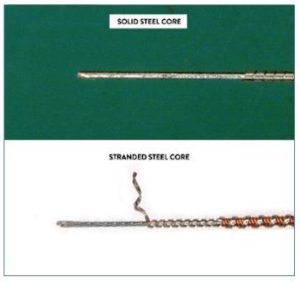
As its name implies steel-core strings are made from thin single steel wire. Stranded steel core strings are made from a thin steel wire that runs throughout the entire length of the string then is wounded with metals such as silver, titanium or steel.
Steel-core strings have a thinner diameter than synthetic or gut strings, which translates in a bright accurate sound with a quick and easy bowing response.
This type of strings tends to remain in tune better than synthetic or gut core because steel is not impacted as much by changes in temperature and humidity.
Synthetic Core
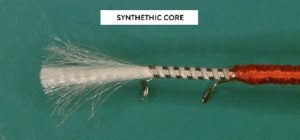
This type of strings is made from synthetic man-made material such as nylon, perlon, stabilon, and Kevlar. They are constructed using strands of fibers wound with metals like silver or aluminum.
The idea behind synthetic strings is to simulate the sound delivered by gut strings while making them more resistant to corrosion, temperature and humidity changes, and better pitch stabilization after installation.
Synthetic-core strings are known for producing a wide range of tones featuring a rich, warm sound with better tone quality, and more subtle tonal effects than steel-core strings. Because of all these features, this type of strings is the most popular for violin players.
Gut Core
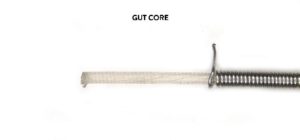
This type of strings were the earliest kind of strings used in violins many years ago. There were made from sheep or cows’ intestines. Gut strings are divided in plain gut or wound gut.
The process to make plain gut strings was to stretch, dry, and twist them to make the string. Wound gut strings have an inner gut core then this is wound with metals like aluminum or silver.
Even though they are the oldest kind of strings they are still used today because they can produce a unique sound that is warm, rich and very complex because overtones are produced when being played.
The cons of this type of violin string are that they don’t stay in tune for long, have a shorter lifespan and are very delicate to changes in temperature and humidity.
String Tension
The tension of a musical instrument string is defined as the stretching force along the full length of the string. String manufacturers like D’Addario determine the tension of a string by the amount of mass (material) wound on the string, as well as the frequency of vibration and string length.
It is important to know that the tension of a string is dependent on the materials used to make the core and the metals used for the external wound. Depending on the manufacturer the tensions and gauges of strings vary. One brand’s medium tension may be significantly different from another brand’s medium tension the reason is that string tension is not standardized.
All string brands offer their products in multiple tension grades: light, medium, and heavy.
String tension and Sound Response
The sound produced by your violin will depend on the tension and thickness of the strings being used. By choosing between light, medium, and heavy tension different sound characteristics can be achieved.
Light-Tension Strings
This string will require less tension to tune the instrument to the correct pitch. With thin gauge strings, your instrument will sound brighter and have a quicker response.
If you install light tension strings on your violin and it sounds dull or unfocused, and you see that the string is over vibrating, you should try a thicker gauge like medium tension strings. Other names used for light-tension strings are soft and dolce.
Medium-Tension Strings
These are the most popular because they deliver an even and balanced tone in the instruments where they are installed. This tension is the most recommended for beginners and intermediate players.
Heavy or High-Tension Strings
Also known as forte are made to be of a thicker gauge. They will produce a louder and fuller sound with a wide range tone but with a slower response. By using the same bowing technique on this string as in lighter gauge strings will produce a louder sound.
Keep in mind that strings of higher tension are made from thicker gauge materials meaning that they will need more force to move them and this could be a problem if you need to play softly. They are more difficult to control than light and medium tension strings.
As mentioned previously, the only way to find out which strings produce the sound you want is by trying them. When you install a set of string you might like the sound of the E and A string from one set and the D and G string from another set, for this reason, another good idea to find your sound is to mix and match different violin strings from different brands, tensions, and core materials until you get the best sound possible.
Frequently Asked Questions About Violin Strings
In this section, we have included some of the frequently asked questions about violin strings to help you understand better and be able to make an educated decision when choosing your next violin strings.
Which tension should I use on my violin?
If you don’t know which tension is best for your violin start with medium tension. If you are a beginner or intermediate, medium tension will work perfectly for you. But if when playing you feel that the string feels soft and the sound is dull, try heavy tension.
If using medium tension and you feel that the volume of your instrument is high, and you want easier bowing response, install a light tension set of strings. Sometimes, players that have experimented with different tensions, and different brands find out that a mix of light, medium and heavy tension strings works best for them because it gives them the tones and sound they are looking for.
What type of core do I want?
If you are a beginner violinist, you might want to start with steel or synthetic core of medium tension. It is recommended to try different brands until you find the sound you are looking for. You could also try mixing and matching different violin string sets to get the sound you like.
What notes are violin strings tuned to?
A violin has four strings. Starting from right side, the Thinnest string is E, the next one is A, the following is D, and the last one, which is the thickest and the one on the left side is G. The easiest way to tune a violin is by using a digital tuner.
Do violin strings make a difference in the sound?
Yes, strings can make a huge difference in sound. But, it is important to keep in mind that each violin is unique, it can be built by the same manufacturer or luthier but each one sounds different. A set of strings that sound good in one violin might not sound the same in another. Therefore, it’s important to try different brands of strings until you find the sound you like.